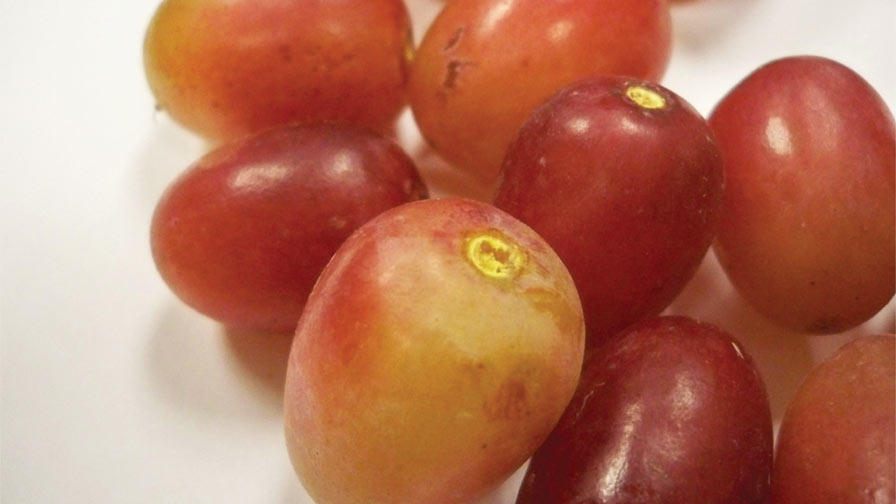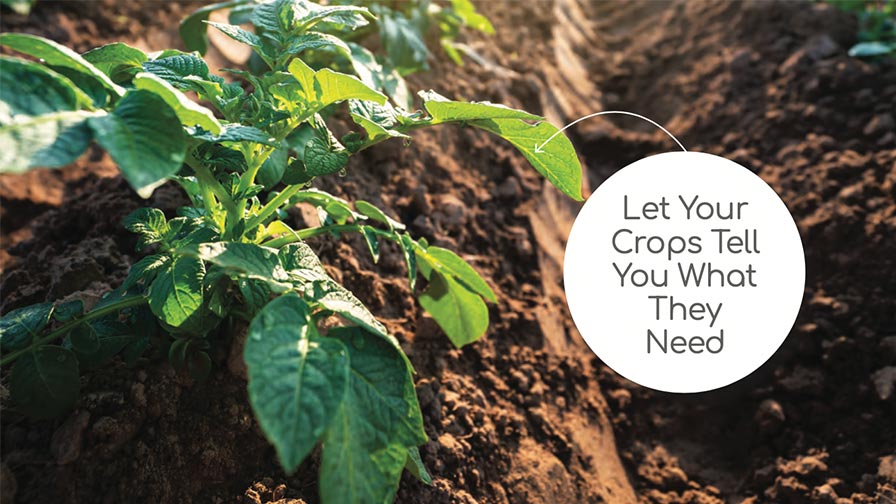There are Many Factors Affecting Table Grapes

‘Crimson Seedless’ grapes with dry stem scars. (Photo credit: Matthew Fidelibus)
The loss of table grape berries from their pedicels, or cap stems, during packing, shipping, postharvest storage, or at the retailer, is known as “shatter.”
Generally the table grape industry tries to minimize shatter because it detracts from the appearance of packed clusters, and may diminish product quality.
In considering the steps needed to minimize shatter, it is helpful to understand the different types of shatter and the factors that affect them. Generally, shatter is grouped into two types: wet, and dry.
Causes Of Wet Shatter
Wet shatter is the result of berries being torn from their cap stems. The pedicel of a berry detached in this way often retains some of the berry’s central vascular bundle — the “brush” — and often some berry skin.
As a result, the detached berry is left with an open “wet” wound on the stem end. This type of shatter is often due to rough handling, and/or excessive packing density.
The overuse of plant growth regulators (PGRs) for berry sizing, including gibberellic acid and forchlorfenuron (CPPU), may also increase wet shatter by thickening the cap stems and making them less flexible.
Wet shatter could also result from decay organisms infecting berry tissues adjacent to the cap stem attachment point. Injury due to rough handling can serve as an entry point for decay organisms, as can micro-cracking, which can also result from the overuse of PGRs for berry sizing.
Causes of Dry Shatter
A type of “dry” shatter can also result from rough or improper handling. For example, stems that make up the cluster framework readily dry and become brittle when postharvest cooling is delayed. This can lead to cap stem breakage, which is considered a type of dry shatter because a berry detached this way retains a short length of cap stem and therefore will not have an open stem-end wound.
The cap stem and berry may also separate cleanly along an abscission zone formed at the cap stem-berry junction. This is also a form of dry shatter, as abscised berries retain their vascular tissues and often have a relatively well developed abscission layer that forms a corky scar on the surface of the stem end of the berry.
This type of shatter is the result of a physiological process and its severity varies according to the season, the variety, and cultural practices used. Advanced berry maturity at harvest and improper cooling also appear to promote postharvest berry abscission.
Preventing Berry Abscission
Although postharvest berry abscission is undesirable when grapes are marketed as whole clusters, as most presently are, the dry stem scar that is characteristic of abscised berries could be considered a desirable trait for stemless “ready to eat” table grapes. Therefore, my lab has been investigating treatments that promote berry abscission.
Berry abscission appears to be naturally regulated, at least in part, by the plant hormones ethylene, which promotes abscission, and auxin, which suppresses it. Research in my lab has also shown that the application of jasmonates, another class of plant hormones, can also induce abscission of mature grape berries, although it appears they may act, in part, by stimulating ethylene production.
Just as ethylene has been shown to stimulate berry abscission, ethylene antagonists appear to inhibit abscission. For example, scientists in China recently showed that treating grapes with 1-methylcyclopropene (1-MCP), a compound that blocks ethylene receptors in plants, thus preventing the plant from sensing ethylene, can dramatically delay and reduce postharvest shatter of grapes.
To my knowledge, there are no PGR products registered for use in controlling berry abscission. However, several labs, including my own, continue to work toward a better understanding of grape berry abscission so that growers may someday be able to facilitate fruit detachment, or increase berry retention, as desired.










